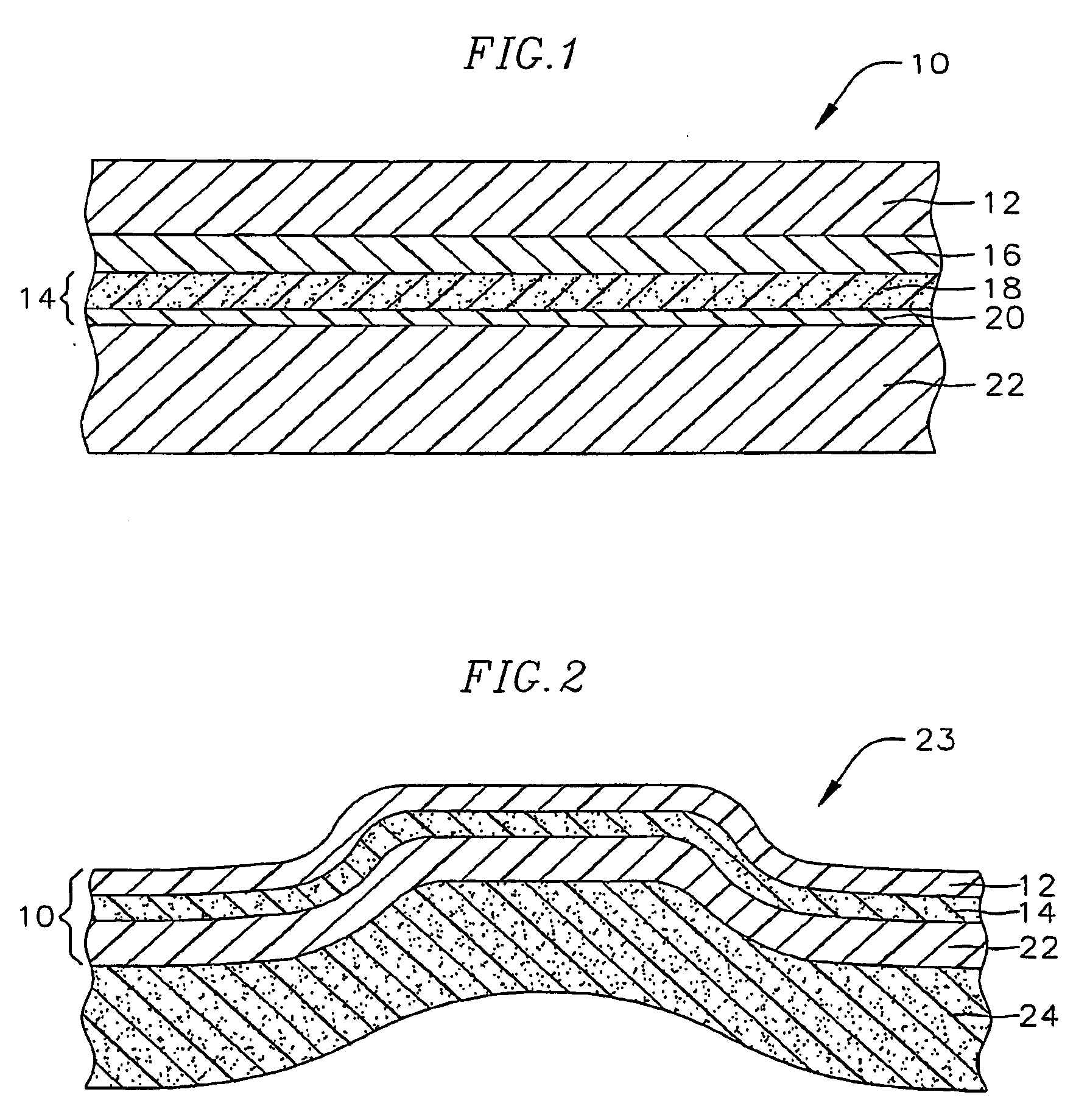High Gloss Laminates for Decorative Automotive Parts
a technology for automotive parts and high gloss, applied in the field of high gloss laminates, can solve the problems of poor chemical resistance of materials such as such things, easy scratching and marring, and difficult processing of acrylics, and achieve the effects of high gloss and doi, enhancing performance, and ensuring the appearance of the vehicl
- Summary
- Abstract
- Description
- Claims
- Application Information
AI Technical Summary
Benefits of technology
Problems solved by technology
Method used
Image
Examples
example 1
[0049]One embodiment of a cellulosic film 12, according to principles of this invention, was prepared using the following formulation:
ComponentsPartsCellulose Acetate Butyrate95Plasticizer3UVA / HALS2
[0050](1) The cellulose acetate butyrate is a material identified as CAB-381, available from Eastman Chemical Company.
[0051](2) The UVA / HALS is a light-stabilizing blend of an ultraviolet absorber and a hindered amine light stabilizer, in a 1:1 ratio. The UVA comprises Tinuvin 928 and the HALS comprises Tinuvin 123, both available from Ciba Specialty Chemicals.
[0052](3) The plasticizer used in this example comprised TOTM (Tri Octyl Trimellitate) available under the designation Palatinol from BASF.
[0053](4) The film solids components were dispersed in a THF (tetra hydra furan) solvent and solvent cast on a stainless steel belt and dried to form a free film. Solids content of the cast cellulosic film-forming material was approximately 20-25%, by weight.
example 2
[0054]The following formulation provides one example of a cellulosic resin / acrylic resin vehicle that can be used for the primer coat and one or more ink layers:
ComponentsPartsPolymethylmethacrylate5.18Cellulose Acetate Propionate5.18UVA0.21HALS0.21Toluene35.69Methyl Propyl Ketone35.69IPOH4.491-Nitro Propane13.36
[0055](1) The PMMA component comprises Elvacite 2021 available from Lucite International Inc.
[0056](2) The cellulose acetate propionate comprises CAP-482-20 available from Eastman Chemical Company.
[0057](3) The UVA comprises Sanduvor 3050 and the HALS comprises Sanduvor 3206, both available from Clariant Corporation.
[0058](4) The 1-Nitro Propane is a multifunctional solvent available from Angus Chemical Company.
example 3
[0059]An acrylic / CAP primer coat can be made from approximately 91 to 92 percent, by weight, of the vehicle in Example 2, together with about 8 to 9 percent, by weight, of an ink diluent comprising the solvents identified in Example 2.
[0060]Alternatively, the solids content of the vehicle of Example 2 can be modified to contain from about 50% up to about 80% acrylic resin and from about 50% to about 20% CAP, to provide alternative primer coat vehicles.
PUM
| Property | Measurement | Unit |
|---|---|---|
| Temperature | aaaaa | aaaaa |
| Temperature | aaaaa | aaaaa |
| Length | aaaaa | aaaaa |
Abstract
Description
Claims
Application Information
 Login to View More
Login to View More - R&D
- Intellectual Property
- Life Sciences
- Materials
- Tech Scout
- Unparalleled Data Quality
- Higher Quality Content
- 60% Fewer Hallucinations
Browse by: Latest US Patents, China's latest patents, Technical Efficacy Thesaurus, Application Domain, Technology Topic, Popular Technical Reports.
© 2025 PatSnap. All rights reserved.Legal|Privacy policy|Modern Slavery Act Transparency Statement|Sitemap|About US| Contact US: help@patsnap.com



